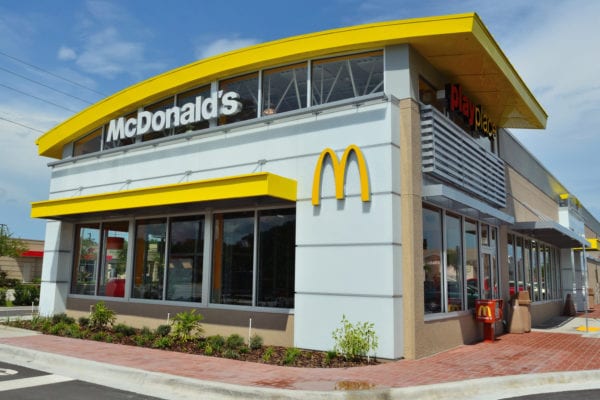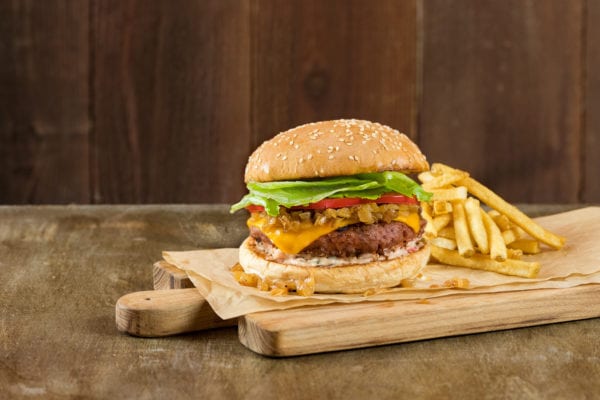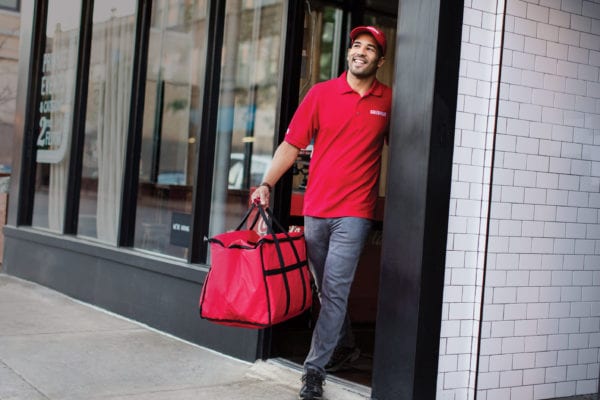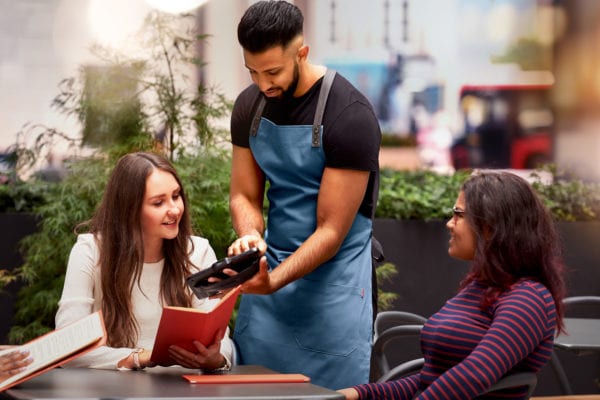I started weekly Chefs+Tech newsletters in March 2013 as a way to highlight creativity and new ideas at the intersection of chefs and restaurants + digital and social technology. These are examples of the news and trends that shaped the best of the best digital content and ideas so far.
A special, heartfelt thank you to April V. Walters , who consistently ups the ante on this project with her gorgeous illustrations (all of the below included.)
I hope you’ve enjoyed the content so far. Cheers to an increasingly awesome 2014.
Kristen
@kh
Chefs on Social

Great things happen when great personalities take advantage of new technology. Hence, Chefs+Tech ’s backbone: the talented, opinionated, smart, driven chefs who use digital media to express themselves inside and outside of the kitchen. It’s part marketing, part personal branding — and when it’s done right, it’s all awesome. Chefs who take advantage of technology and digital tools become more personable and reach a wider audience, even if their food reaches only a regional crowd. Here’s a look at who did it best in 2013:
In April, Jose Andres informally challenged Anthony Bourdain to a hilarious tapas photo-off while Bourdain spent time in Spain. The result: drool-inducing dishes from two of the chefs who know tapas best, and a jealousy-inducing look into what they deem worth eating. Plus, some of the best witty banter out there .
Then there’s Mario Batali , who manages to be everywhere, all at once . Seriously, one would want to hate this dude for his success if not for his consistently spectacular restaurants, hilarious Twitter quips, helpful cooking advice, and willingness to talk to so many of his fans who reach out online.
Another stellar example of how great content comes from showing a bit of personality: Chicago’s Grant Achatz created a great video , set first in the grocery store, then in his kitchen. he’s taste-testing canned soup, and crowns his favorite at the end, after much fanfare. This is especially effective given the seriousness with which we usually talk about Achatz; running some of the top restaurants in the country takes some serious effort (and serious seriousness), this fun, funny look into the man behind all of that is great for a laugh.
Social media is good for more than personal lives; plenty of chefs used it to market themselves and their talents. One of my favorites: Tyler Florence’s Test Kitchen on Instagram , a series of instructional and interactive cooking photos, appropriately hashtagged #TFtestkitchen. Similarly, Gordon Ramsay hosted a Twitter cook-along , where he cooked fried chicken live on Twitter, tweeting all of the steps, important time stamps, photos for comparison, and plenty of great tips and cooking knowledge. A chef’s-eye-view is hard to beat.
It’s not all sunshine and rainbows. Case in point: Eric Ripert, who posts gorgeous photos, great ideas, awesome conversations… and then deletes them an hour later. Still not sure why he’s still doing this, but clearlyhe still hasn’t read the open letter . I wrote in June. Seriously, chef, leave the content. It’s great!
Of course there’s the rule-breaker: Alton Brown doesn’t hide his Twitter dislike , but managed to construct his own system — writing out Tweets on post-it notes, photographing them and tweeting only a link to the image. For all of this rule-bending behavior, the response from fans and followers is still quite strong. And he’s kept it up ! Better to kind-of tweet than not to tweet at all.
And a shout-out to one of my personal favorites, Chicago’s Stephanie Izard , who embraces Twitter daily — and isn’t afraid to mock herself in hilarious fashion. Her always-interesting posts document her trips to the market, menu-writing and special-choosing at her restaurants, and just enough food porn to make me book a trip to Chicago to finally visit her spots. Consistently awesome, and worth a follow — a favorite example of voice, tone, personality, and fun.
Rad Restaurants Doing Smart Things
Restaurants that take advantage of technology and digital media become more relevant and stand out in a sea of sameness. Successful spots work hard to create an experience; elements from building materials to colors to lighting to barware to flatware are meticulously curated. As the digital space extends to encompass more elements of offline life, continuing this experience online is mission-critical to success.
Stepping inside a restaurant gives you an immediate idea of what to expect; its food, its service, its tone, its personality. Plenty of top-notch spots translated this feeling into digital content, to great success. No one does this better than Grant Achatz ’s Alinea and Next , which employ their own creative team to create the awesome videos like this “trailer” from Next promoting its next dinner program . The restaurants are dinner-as-theater on their own; but these creative digital videos take the experience to the next level, translating them for anyone — even those without tickets to the main event — can enjoy. Similarly, Empellon , the New York City restaurant from chef Alex Stupak , has its own video channel , posting how-to videos for everything from cocktails to a Scotch egg. The videos are beautifully shot, and give a great sense of the restaurant itself.
Let’s talk mass market. Arguably, Taco Bell ’s Doritos Locos Taco would not have taken off as it has without the power of social sharing. (Remember the first time you saw one?) Fittingly, the restaurant chain used Instagram to announce the third flavor in the Locos Taco series, counting on the power of the social share to promote the new, spicy item. It worked — in fact, I think the marketing got more attention than the flame-flavored taco itself.
Then, a tale of two San Francisco restaurants: much-loved 4505 Meats announced its new barbecue restaurant via Twitter , and its future home neighborhood reacted with tweets of support and sheer glee. Then, pop-up Hapa Ramen made a Twitter announcement of its own, promoting (California-banned) foie gras ramen.Twitter reacted , though not quite the same way. Quite entertaining to watch.
Also, a few quick lessons on what not to do. Don’t take advantage of news to “slyly” market anything . Looking at you, McDonalds . Don’t use social media to call out customers , especially for tipping. And if you’re going to tout a new, convenient, crowd-pleasing digital feature to the masses, make sure it works . #Cronutpocalypse2013
#FoodPhotos
Food photography used to be considered an art form. Magazines paid photographers and stylists to create those drool-worthy food shots. Now, thanks to the proliferation of mobile devices with decent cameras, real-time food photos posted on social networks have become a whole thing.
First, we learned that posting food photos makes you fat . Then, we learned that looking at food photos helps you lose weight . Mostly though, we learned that everyone — academics included — has an opinion about food photos on social networks.
One smart New York restaurant took advantage of social promotion , offering a discount if patrons Instagrammed their food at Brooklyn’s Smorgasburg . On the flip side, a Buzzfeed video pokes fun at the phenomenon, asking, “ Why are you Instagramming that ?”
In-the-moment food photos probably wouldn’t be so bad if they looked like the styled, well-lit, thoughtful photos we see in magazines and other productions. But… they don’t. And no one is immune. Not even the most well-documented perfectionist in the history of perfection: Martha Stewart , who, after posting the offending images, legitimately didn’t understand the social media response. (Probably good that highly trained and talented professionals run the MSL empire’s photography teams.) Similarly, a man who makes his living by spending time in and writing about restaurants admits his own troubles with mobile food photography. In fact, there’s an actual Instagram account dedicated to re-posting some of the worst offending photography .
Instagram smartly capitalized on all of this buzz, and acknowledged the platform as a good spot to chronicle food and restaurant experiences in real-time, announcing video with a real-life restaurant example .
Of course, every trend has its h8ers, and food photograhpy is no exception. Sure, at times they’re hideous and intrusive when shared incessantly, but for some people, these social photos serve as a kind of record of what and where they’ve eaten. (I am one of these people.) Just in time, San Francisco’s inside Scoop published agreat defense of food-photo-sharing .
Finally, the best food Instagram post of the year came via NPR’s stop-motion dumpling how-to , in honor of the station’s dumpling week. Smart, smart stuff. More please!
All About Menus
If the kitchen is the heart of a restaurant, the menu is its soul. Menus present a compact and concise look at what a restaurant offers; words, fonts, colors, and tone enhance this message — not to mention that a physical menu is often the best promotional real estate in the entire restaurant. Injecting a dose of digital just means more creativity and more opportunity.
Generally, there’s no stealth way to whip out your phone (or a camera) during a restaurant meal to take a photo without enduring some sort of judgement (from the table next to you, from your waiter, from your dining companion). Regardless, the socially-shared food photo is a whole thing (see above), and cleverly addressing it on your menu is a good thing. The smarties at New York’s Empellon found a fun way to encourage “responsible” sharing by including a cheeky line on the menu :
Empellon strongly discourages the use of cell phones, unless you’re posting food porn on Instagram. #Empellon
In contrast, Chicago chef Graham Elliot posted a photo of a menu on Instagram of a different opinion :
Cell phones, tweeting, and e-mailing,” it reads, “have been proved harmful to other diners. Please refrain.
(Love that he posted this on Instagram, btw.)
Appropriately, even the menus themselves are getting a refresh as technology seeps deeper into the restaurant experience. In October, NPR offered a great rundown on the current state of the digital menu phenomenon . Detailing benefits (offering far more information than would otherwise fit on a paper menu; tap-and-click ordering directly from the menu) and a few downsides (costs; imposing a new technology), the piece provided a general understanding of the very latest in menu technology.
Perhaps the biggest story in digital menus (this one went all the way to mainstream national news): massive fast-casual chain Applebees will introduce tablets and tablet-based ordering to all of its restaurants in 2014. Applebees doesn’t plan to cut the waitstaff significantly, which would, in my opinion, dramatically alter the experience one has come to expect at a “neighborhood” place. But they do hope to improve efficiency and (seriously) decrease boredom, as patrons can play games on the tablets while waiting for their meals to arrive. The future!

Ratings, Reviews, Inflated Egos
No trend was more ridiculous this year than the attention and crazy consequences of everyman online restaurant review sites — Yelp, of course, the easiest target. Its model allows the self-righteous to yell a little too loudly, the armchair “reviewer” to assert undeserved authority a little too easily. Ridiculousness within:
A thesis: to comprehend a restaurant review, the reader needs to understand from whom and where it originated. Hence, publications hire seasoned, vetted restaurant reviewers with chops that the average person can trust. Wired captured this sentiment in a humorous and spot-on flowchart: Should I Trust This Yelp Review?
Without that trust and understanding, the “review” space is, at best, full of hot air. And at worst, manipulating — like when customers threaten bad reviews if they aren’t given what they want , or when dishonest restaurantssolicit favorable and completely fake reviews .
If the word on the street is true, though, Yelp hasn’t done all that much for its part, reportedly burying favorable reviews of restaurants that don’t pay to advertise. Reports of this are so credible, that the LA Times ran an editorial asking readers to boycott Yelp . Even Mario Batali chimed in, explaining via Twitter that he doesn’t even look at Yelp reviews because,
“I’ve never learned anything useful from anonymous criticism.”
Well said, sir.
Perhaps no piece of crowd-sourced review news was more ridiculous this year than (this is my favorite) the Yelp reviewers’ ridiculous lawsuit that claimed Yelp reviewers are “unpaid writers” who should be compensated for their contributions. (Seriously, this thing is so ridiculous it’s worth a click through to read the filing in its entirety.)
Admittedly, Yelp and its ilk do agree that blatantly fake, inflated, or otherwise untrue reviews are a real problem on the internet. They say they’re constantly working to improve algorithms to determine real from fake.
Maybe this is the year.

The Best of the Rest
And, finally, a quick look at some of the top food + tech headlines of 2013. These stories represent some of the most interesting developments in the space over last year-ish. Aside from encouraging, creating, and promoting creative content, digital and social tech changes all aspects of the food and technology industry. These are just a few of the awesome ideas, products, and other technology that is changing the way we grow, buy, consume and think about food.
- The USDA releases a Farmer’s Market directory API , allowing app developers to tap into its data.
- EatWith allows you to experience a meal at someone’s home in another country . Like the “AirBNB for dinner.”
- Both the US and Australia welcomed our robot overlords by farming with drones + Farming US farmers + Drones
- Food blogs have changed how we eat out. This is how .
- Smartly, it is possible to d igitally track your food from farm to plate .
- Some thoughts on how digital media changes live food events . (Spoiler: you can’t live-stream them like a music festival.)
- Farmers are using social media to reduce food waste .
- In Japan, you can buy and farm a plot of land via webcam . (You have to visit on the weekend, though.)
So What’s Next?
If the past year is any indication, chefs and restaurants will continue to rapidly embrace digital and social technology to keep their establishments relevant. Our physical and digital lives continue to blend. With their historical (and important!) attention to etiquette, these same chefs and restaurants will set the tone for the way we experience dining and restaurants.
I can’t wait to see what happens next.




